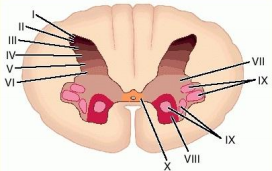Type of pain experienced by the woman in the scenario
The mechanism through which the woman experiences pain works in the principle of Gate Control Theory. The Gate Control Concept argues that the pain sensitivity occurs through equilibrium between the action of nociceptive Aδ and C-fibers and non-non-nociceptive Aβ fibers (McCance, & Huether, 2014). The Gate Control model involves the interplay of four types of neurons present in the spinal cord’s dorsal horn region and involves projection neurons; nociceptive Aα and C-fibers; Aβ fibers; and inhibitory interneurons. The inhibitory interneuron normally remains active and inhibits the projection neuron, thereby blocking the transmission of the pain signals from nociceptive fibers. Under a noxious stimulus, the intensity of the pain signal traveling through the nociceptive fibers reduces the interneuron’s inhibition of the projection neuron thus letting the experience of pain occur. When non-nociceptive fibers are stimulated, the interneurons start to inhibit the projection neurons from transmitting the pain signal to the brain. In the case of the patient, massaging will provide pain relief through activation of non-nociceptive large fibers that inhibit the conduction of pain signals in the nociceptive Aδ and C-fibers.
Rexed’s classification of the spinal lamina

According to Rexed’s classification system, the cross-sectional spinal gray matter is divided into ten laminae numbered 1 to X from dorsal to ventral direction comprising the dorsal horn area (Laminae I to VI) and the ventral horn (VII to X). Lamina I (marginal layer) and laminae II (substantia gelatinosa) consist of the majority of nociceptive neurons that intercept direct synaptic input from C and Aα fibers. Lamina I neurons predominantly respond to noxious stimulation while some neurons are capable of responding to both noxious and non-noxious insults. Lamina II comprises both excitatory and inhibitory interneurons, of which a few are stimulated only by the nociceptive signals and others by the non-noxious stimuli. The Bβ fibers form monosynaptic contact with neurons of the lamina III and IV that predominantly transmit non-noxious signals to the higher brain centers. The neurons of the lamina V receive pain signals from both Aα and Bβ fibers and transmit them to the stem of the brain and areas of the thalamus. The C-fibers also transmit pain input to lamina V neurons either directly through its dendrites or indirectly through interneurons. The input received by the neurons of lamina IV are non-noxious and transmitted through large-diameter afferents (Aα and Bβ fibers) from muscles and joints. The ventral horn neurons of lamina VII and VIII contribute to the sensation of diffuse pain as it receives polysynaptic nociceptive inputs and in contrast to the dorsal horn neurons, inputs from either side of the body are received. The lamina X neurons surround the central canal of the spinal cord and receive pain input from both myelinated and unmyelinated afferents with axonal projections reaching medullary targets (Baron, 2006).
The Spinothalamic track is the most prominent and well-understood pathway located in the ventrolateral white matter of the spinal cord that projects second-order neurons to the thalamus (Renn & Dorsey, 2005). The activation of limbic structure in the patient occurs due to paleo-spinothalamic tract excitation and is linked to the motivational aspects of the pain. The transmission of information through the neo-spinothalamic tract activates the ventrobasal and posterior thalamus which is important in localizing pain-related sensations and their intensity. Pain is experienced when the spinothalamic tract is electrically stimulated. However, if lesions are induced through anterolateral culdotomy, pain sensation is markedly relieved.
References
Baron, R. (2006). Mechanisms of disease: Neuropathic pain—a clinical perspective. Nature Clinical Practice Neurology, 2, 95-106.
Kim, D. H., Betz, R. R., Huhn, S. L., & Newton, P. T. (2011). Surgery of the pediatric spine. New York, NY: Thieme Medical Publishers, Inc.
McCance, K. L., & Huether, S. E. (2014). Pathophysiology: The biology basis for disease in adult and children. St. Louis, MO: Elsevier Mosby.
Renn, C. L., & Dorsey, S. G. (2005). The physiology and processing of pain: A review. AACN Clin Issues, 16(3), 277-290.